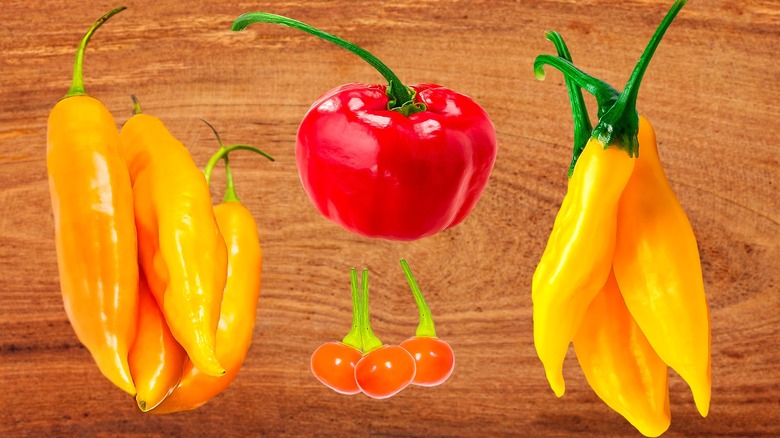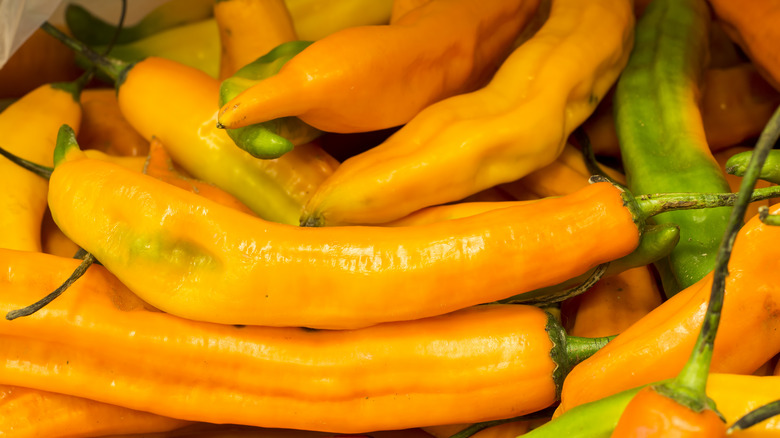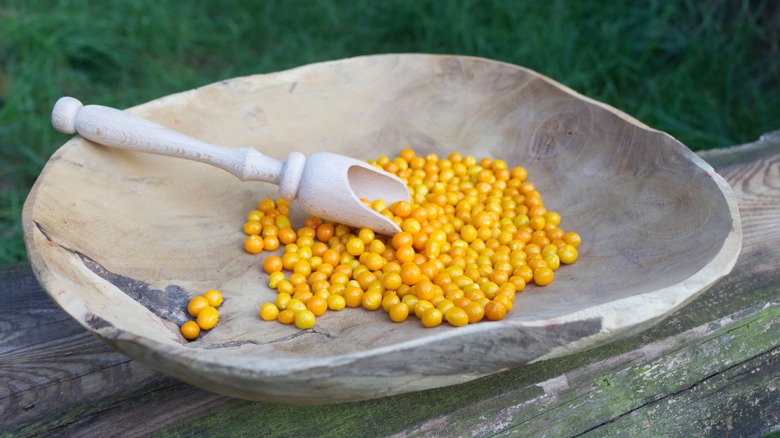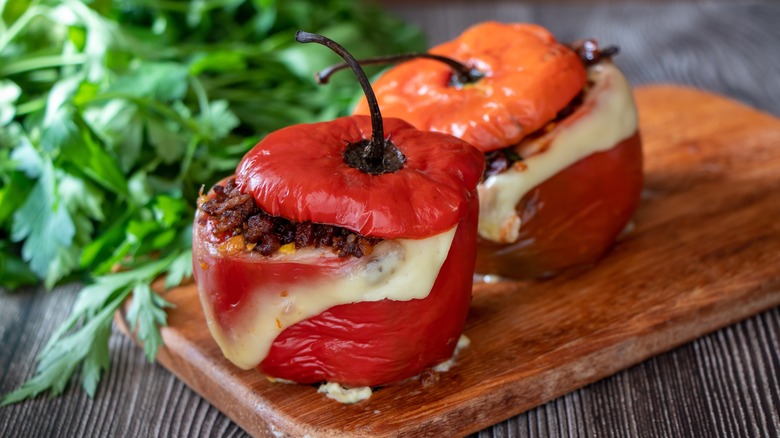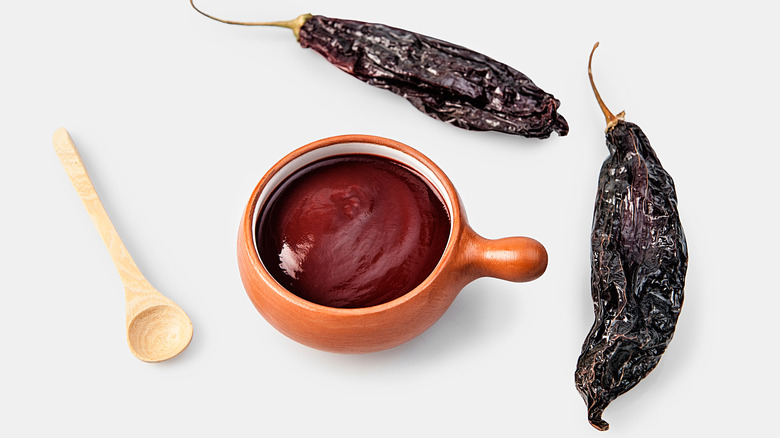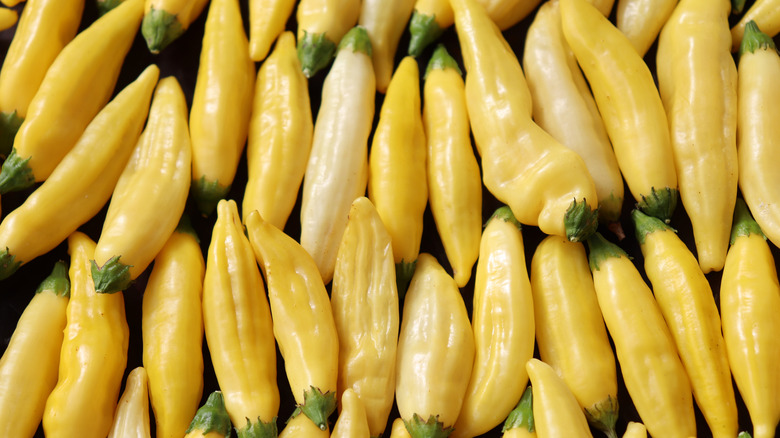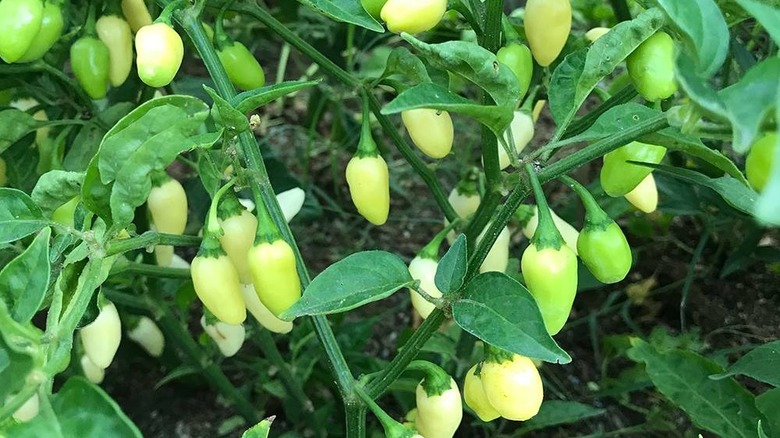6 Types Of Peruvian Peppers You Should Know
If you've been sleeping on Peruvian cuisine, it's time to get yourself acquainted. The country gifted the world with potatoes — that's right, the potato plant was first cultivated in Peru. Beyond that incalculable contribution to world gastronomy, the country's modern restaurant scene is also amazing. Central, a restaurant in Lima, Peru, was named the World's Best Restaurant 2023 by 50 Best.
Of course, potatoes figure heavily into Peruvian recipes, but chiles (or ají, as they're known in Peru), are just as important. It's hard to find a classic Peruvian recipe that doesn't incorporate at least a touch of chile heat. Peruvian cooks use completely different types of chiles than what you'll find in the average American grocery store, and native peppers are a big part of what gives the nation's food its special flavor. This article breaks down some of the most common Peruvian peppers, explaining what they taste like and how you can find them in the U.S.
1. Ají amarillo
Ají amarillo is the most prominent and widely-used chile pepper in Peruvian cuisine, so much so that it's sometimes simply called "Peruvian pepper." It's a relatively slender, pointy pepper that can range from bright yellow to orange depending on ripeness. This chile's flesh is bursting with juicy, fruity, and spicy flavor. Its sweet, tropical notes are reminiscent of scotch bonnets or habañeros, but with much less extreme heat — topping out at 50,000 Scoville Heat Units rather than 350,000. This is still up to 20 times hotter than a jalapeño, however, so ají amarillo is best enjoyed by people with at least a moderate heat tolerance.
The easiest way to find ají amarillo in the U.S. is in jarred, pureed form. This is perfect for one of the most common uses of the pepper: an orange, creamy sauce blended with mayonnaise, dairy, or bread. This is the type of sauce that coats cooked potatoes in the dish papa a la Huancaína and mixes with shredded chicken to make ají de gallina.
Ají amarillo paste can also be used to make the classic Peruvian beef-and-potato stir-fry lomo saltado, but it's even better if you can find fresh chiles to slice and saute with the rest of your ingredients. Fresh ají amarillo also makes frequent appearances in ceviche, a dish that's now popular all over Latin America but which was born in Peru.
2. Ají charapita
Ají charapitas are indigenous to Peru's jungle areas, where they are ubiquitous and appear in a wide range of dishes. Despite their diminutive form — about the size of a pea — they are quite hot. At the lower ranges, the charapita is about the same spice level as an ají amarillo, at 30,000 Scovilles, but this chile can reach 100,000 Scovilles, hotter than most people would enjoy eating on its own. For this reason, it's usually mixed with other ingredients that temper its heat, like in ají de cocona, a type of fresh fruit salsa. Like ají amarillo, the dominant flavor in ají charapita is tropical fruit, but charapita has more of a bright, citrusy edge.
There is a persistent myth online that ají charapitas are the most expensive chiles in the world. This is certainly not true in the regions where they're grown — they're quite common and affordable in the Peruvian jungle. While they're more rare, and thus more expensive, in the U.S., you can still pick up jarred paste or dried peppers for somewhat reasonable prices. If you'd like to grow your own, which is probably the best option if you want to eat fresh charapitas in North America, the seeds cost only a few dollars.
3. Rocoto
The rocoto pepper looks sort of like a bell pepper or an apple, but its cute appearance belies its impressive capsaicin content: up to 100,000 Scovilles. Unlike the previous two chiles we've discussed, rocotos are popular well outside the boundaries of Peru; they're quite common in Bolivia and they're well-known in certain regions of Mexico as well. Depending on where you live, they might be called "manzana" peppers ("manzana" means "apple" in Spanish), but they shouldn't be confused with another similar-looking but much less spicy chile that goes by the same name. Rocotos may be bright red, gold, or green in color.
Rocotos may be eaten in a variety of ways, including raw in salads, but their most distinctive application takes advantage of their large size and globular shape: rocotos rellenos, or stuffed rocotos. This dish is much like the stuffed bell peppers you may have grown up eating, but with an added kick from the rocotos. The filling typically contains chopped or ground beef and seasonings like peanuts, raisins, and onions. To make the heat less overbearing, the chiles are usually pre-cooked in water mixed with sugar and/or vinegar. A creamy sauce also helps to tame the spice.
4. Ají panca
Ají panca looks similar to ají amarillo, with its slender, tapered shape and medium size. The two chiles are, in fact, related — they're both from the capsicum baccatum family, a type of chile that tends to be sweeter and fruitier than the capsicum annum chiles we're familiar with in North America (bell peppers, poblanos, jalapeños, and serranos are all from the capsicum annum family).
The two things that most distinguish ají panca from ají amarillo are its red-brown color and its relative lack of heat; panca chiles register at a mere 1,000-1,500 Scovilles, mild enough for all but the most fervent spice-haters. Don't let the toned-down heat make you think these chiles are bland, however. They're filled with a dark fruitiness that's reminiscent of fresh berries, along with a distinct smokiness. You can find ají panca fresh in Peru, but it's more common to see them processed into a paste or dried and sold either whole or powdered.
One of the classic uses for ají panca in Peruvian cuisine is as a part of the marinade for anticuchos, or grilled meat skewers. The chile, along with garlic, oregano, and other seasonings, adds a deep savoriness to cubes of red meat (originally llama, but now more commonly beef heart).
5. Ají limo
This is the most confusing entry on our list. There are actually two Peruvian peppers known as ají limo/ají limón. One is from the capsicum chinense family, while the other is a type of capsicum baccatum. To make things even more murky, both plants produce yellow peppers that look quite similar. The two types of chiles also share a citrusy flavor and may be labeled as "lemon drop" chiles in the U.S. This has led some sources to claim that there is no difference between the two chiles, but this is false.
The true ají limo tends to be hotter than the ají limón/lemon drop pepper. The former can be up to 50,000 Scovilles, while the latter resides in 15,000-30,000 Scoville territory. And while lemon drop peppers tend to stay yellow, ají limo fruit will ripen to an orangy red color if left on the plant long enough. However, other than the difference in heat, they taste very similar, so they can be used for many of the same applications — they both make for a delicious, bright hot sauce, and their citrusy kick works well in ceviche. Select which one you use based on your own spice tolerance.
6. Peruvian white habañero
Most of the chiles we've discussed so far have at least a decent amount of heat, but none of them will blow away someone with a high spice tolerance. Enter the white habañero, the Peruvian chile of choice for people who just can't get enough spice. Milder examples of this chile have about the same heat level as a particularly spicy rocoto or ají charapita, but the hottest ones are a tongue-melting 350,000 Scovilles — 140 times hotter than an average jalapeño.
Peruvian white habañeros have a similar flavor to the common orange habañeros you can find in most grocery stores — fruity and citrusy with a bit of smokiness. The main way they differ from their more famous cousins is aesthetics. As you might guess, they have a striking off-white color. They're also much smaller than standard habañeros, with a form factor that has been compared to jelly beans and bullets. While you're unlikely to find this pepper in a supermarket, seeds are widely available online. Unless you're a true spice fiend, you'll want to use white habańeros in ways that allow you to add just a touch of the chile to your food, like in hot sauces or salsas.
